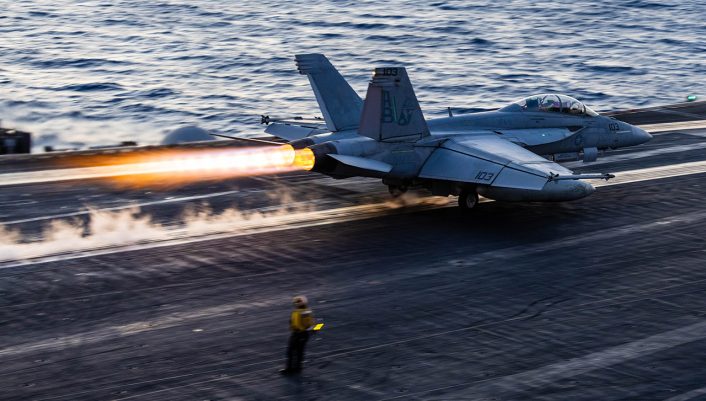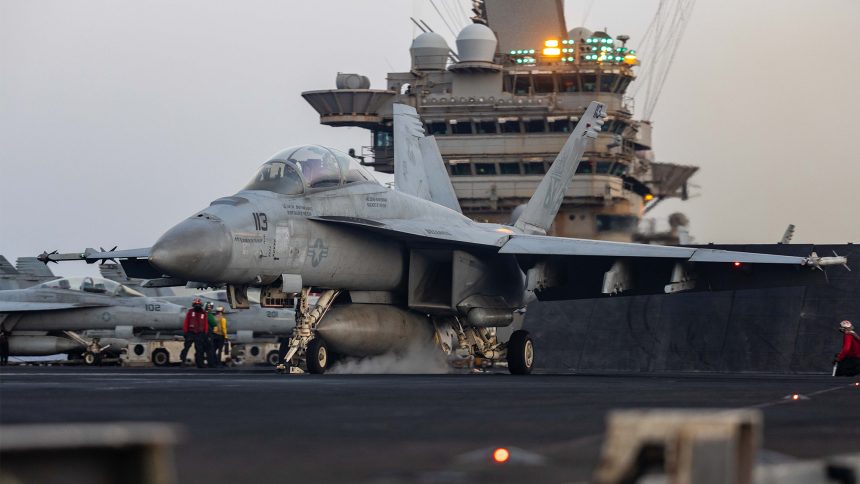An F/A-18F Super Hornet from the USS Harry S. Truman crashed into the Red Sea, according to CNN sources. Both crew members ejected successfully, and were recovered with minor injuries. The jet is the second Super Hornet lost from the Truman in just over a week, and the third overall on the ship’s current deployment.
According to multiple sources speaking to CNN, the incident occurred on landing and was potentially due to a fault with the arresting wire system. This would cause the aircraft to overrun the landing area and drop into the sea ahead of the ship. Those on board the fighter, a pilot and a weapon systems officer (WSO), were able to eject from the aircraft and were recovered via helicopter with minor injuries.
Breaking: Another F/A-18 Super Hornet fighter jet from the USS Harry S. Truman aircraft carrier has been lost in the Red Sea after it suffered an arrestment failure while trying to land. 2 aviators ejected, were recovered by helo with minor injuries. https://t.co/PPqs2wP2oz
— Natasha Bertrand (@NatashaBertrand) May 7, 2025
As two crew members ejected, this narrows the aircraft down to being an F/A-18F variant operated by VFA-11, the ‘Red Rippers’. Each U.S. Navy carrier air wing features either one or two squadrons of twin seat F variants, which trade off a slightly lower fuel and payload capacity in favor of a WSO who can act in a Forward Air Controller (FAC) role as well as generally ease the pilot’s workload.
The jet becomes the second Super Hornet lost from the Truman in just over a week, and the third overall on the ship’s current deployment. In December, another F/A-18F was shot down by U.S. Navy cruiser USS Gettysburg in a friendly fire incident as the carrier strike group faced Houthi attacks. Then, in late April, an F/A-18E was lost overboard along with a tow tractor as the aircraft carrier reportedly performed evasive maneuvers.

With three Super Hornets now resting, along with any sensitive materials or technologies on board, at the bottom of the Red Sea, an extensive recovery operation is likely to be in the works to prevent the wreckage falling into the hands of adversaries. Such an operation could only take place once the threat of attack from Houthi missiles and drones has subsided.
This may now come sooner rather than later amid reports of a ceasefire between the U.S. and the Yemeni rebel group. However, it remains to be seen whether such a ceasefire will hold – the same sources that informed CNN about the Super Hornet incident also said that the Houthis had attempted an attack on the Truman on May 6.
Since March, the U.S. military has intensified its military operations against Houthi targets. Airstrikes have been delivered by carrier based aircraft from both the USS Harry S. Truman as well as the F-35C equipped USS Carl Vinson. B-2 Spirit stealth bombers operating from Diego Garcia in the Indian Ocean have also participated in the strikes, which the U.S. have codenamed Operation Rough Rider. The UK has also joined at least one of these missions using Typhoons from RAF Akrotiri.
Today, GEN Michael Erik Kurilla, USCENTCOM Commander, embarked the aircraft carrier USS Carl Vinson (CVN 70) and thanked the Sailors for their professionalism, competence, and dedication in support of continuous operations against the Iran-backed Houthis in Yemen. pic.twitter.com/sQVtHBtnpn
— U.S. Central Command (@CENTCOM) April 27, 2025
The Truman, which has had its deployment extended several times, has had an eventful time at sea. Along with the loss of three of its combat jets, the aircraft carrier suffered a collision with a merchant vessel in February which caused visible damage to several parts of the ship.
In addition, in March reports emerged that a U.S. Navy E-2D Hawkeye had suffered a Class A mishap but safely landed at an undisclosed location. Though neither the location or the host carrier were revealed by the Naval Safety Command listing, a singular E-2D Hawkeye was noted making an Oceanic crossing via Lajes in early April towards the Mediterranean Sea. This would align closest with the Truman’s operating area at the time.
On March 20, a USN E-2D had an in-flight mishap somewhere and was able to land safely, according to a NAVSAFECOM tally of Class As: pic.twitter.com/Ww5pEKl5U7
— Brian Everstine (@beverstine) March 27, 2025
When the carrier eventually returns home, the candidate to take its place is the USS Gerald R. Ford. The Ford is the newest active aircraft carrier in the U.S. Navy and the first of its namesake class. Between March and April the ship completed its Composite Training Unit Exercise, or COMPTUEX, the final training program undergone by each U.S. Navy aircraft carrier before commencing a deployment. It is currently at Norfolk Naval Base awaiting a departure date.









